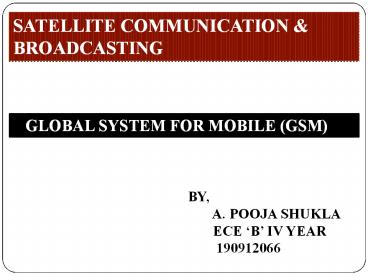GSM, global system for mobile - PowerPoint PPT Presentation
Title:
GSM, global system for mobile
Description:
GSM, global system for mobile, 2g technology – PowerPoint PPT presentation
Number of Views:2425
Updated: 22 January 2014
Slides: 20
Provided by:
190912066
Category:
Medicine, Science & Technology
Tags:
Title: GSM, global system for mobile
1
SATELLITE COMMUNICATION BROADCASTING
GLOBAL SYSTEM FOR MOBILE (GSM)
BY, A. POOJA SHUKLA ECE B IV
YEAR 190912066
2
HISTORY OF GSM
- GSM was first introduced in the European market
in 1991. - In 1982, it was recognized as a standard for
digital wireless communications. - GSM was first named as Group Special Mobile.
3
(No Transcript)
4
WHAT IS GSM.?
- GSM is a second generation cellular system
standard. - It was developed to solve the fragmentation
problems of the first cellular generation. - It is an 1st cellular system to specify digital
modulation and network level architectures and
services. - It uses an 2G technology.
5
- It is an open system and non propriety
technology. - The greatest feature of GSM is international
roaming.
6
GSM SERVICES AND FEATURES
- GSM services and features are classified into
three major types. They are shown below, - Telephone Services
- Data Services
- Supplementary ISDN Services
7
TELEPHONE SERVICES
- It is also called as teleservices.
- The teleservices provides the following
services, - voice calls
- videotext and facsimile
- short text messages (SMS)
8
DATA SERVICES
- It is also called as bearer services.
- They are limited to layers 1,2 and 3 of the OSI
model. - Services include packet switched protocols and
data rates from 300 bps to 9.6 kbps. - Data may be transmitted using either a
transparent or nontransparent mode.
9
SUPPLEMENTARY SERVICES
- This service is provided on top of data
services or teleservices. - It includes the following features,
- multiparty services or conferencing
- call waiting
- call hold
- call forwarding
- call diversion
- caller identification
10
GSM SYSTEM ARCHITECTURE
11
PSTN ISDN PDN
BSC
MS
BTS
MSC
GMSC
BSC
BTS
VLR
MS
EIR
BTS
AUC
MS
HLR
12
- GSM network can be divided into following broad
parts, - Mobile Station (MS)
- Base Station Subsystem (BSS)
- Network Switching Subsystem (NSS)
- Operation Support Subsystem (OSS)
13
- The components of GSM architecture include the
functions of databases and messaging systems, - Home Location Register
- Visitor Location Register
- Equipment Identity Register
- Authentication Center
- SMS serving Center
- Gateway MSC
- Charge Back Center
- Transcoder and adaption unit
14
GSM OPERATION
15
GSM CHANNELS
Downlink
Channels
Uplink
- Physical Channel Each timeslot on a carrier is
referred to as a physical channel - Logical Channel Variety of information is
transmitted between the MS and BTS. Different
types of logical channels - Traffic channel
- Control Channel
16
GSM NETWORK AREAS
- The basic service areas of GSM are given below,
- Cell Service Area
- Location Area
- MSC Service Area
- PLMN Service Area
17
GSM FRAME STRUCTURE
18
ADVANTAGES OF GSM
- Crisper, cleaner quieter calls
- Security against fraud and eavesdropping
- International roaming capability in over 100
countries - Improved battery life
- Efficient network design for less expensive
system expansion - Efficient use of spectrum
- Advanced features such as short messaging and
caller ID - A wide variety of handsets and accessories
- High stability mobile fax and data at up to 9600
baud - Ease of use with over the air activation, and all
account information is held in a smart card which
can be moved from handset to handset
19
THANK YOU..!!!































